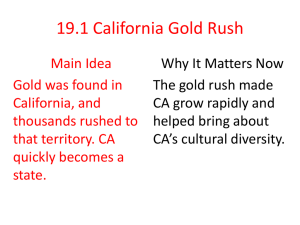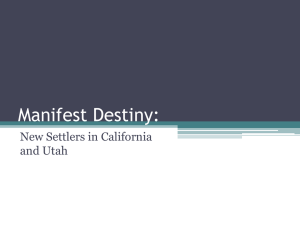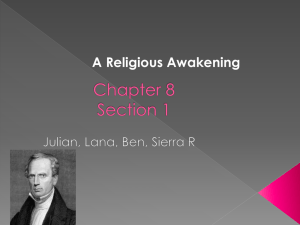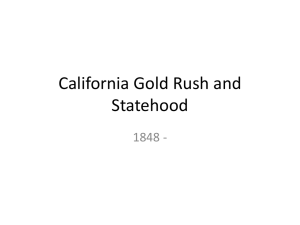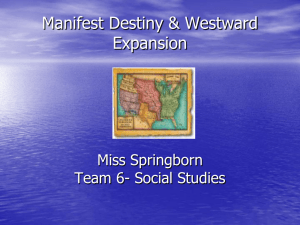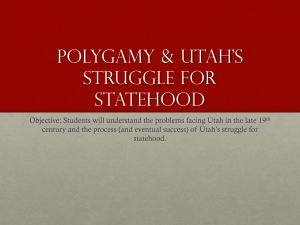A Rush to the West
advertisement
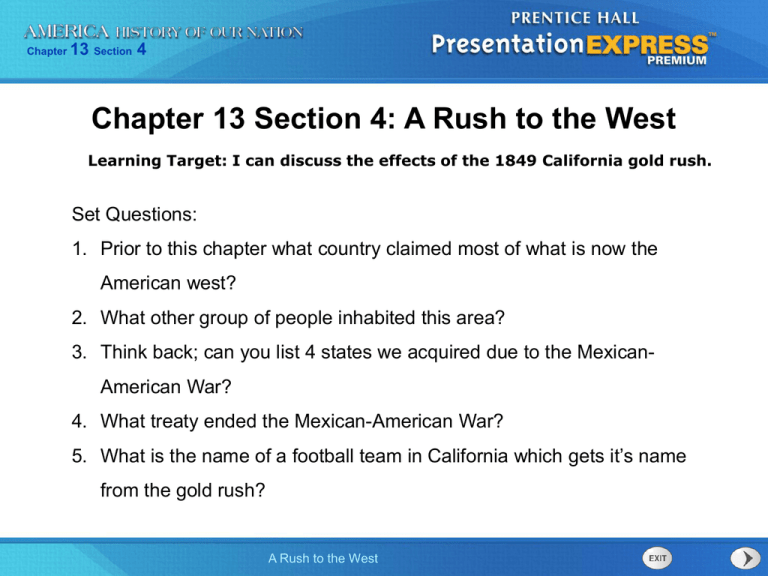
Chapter 13 Section 4 Chapter 13 Section 4: A Rush to the West Learning Target: I can discuss the effects of the 1849 California gold rush. Set Questions: 1. Prior to this chapter what country claimed most of what is now the American west? 2. What other group of people inhabited this area? 3. Think back; can you list 4 states we acquired due to the MexicanAmerican War? 4. What treaty ended the Mexican-American War? 5. What is the name of a football team in California which gets it’s name from the gold rush? A Rush to the West Chapter 13 Section 4 Objectives • Explain why the Mormons settled in Utah and examine the issues that divided the Mormons and the federal government. • Discuss the effects of the 1849 California gold rush. • Describe how California’s population had changed by 1850. A Rush to the West Chapter 13 Section 4 Terms and People • Joseph Smith – a New York farmer who, in 1830, founded the Church of Jesus Christ of Latter-day Saints • polygamy – the practice of having more than one wife at a time • Brigham Young – a Mormon leader who led the Mormons to Utah • forty-niner – a nickname given to people who went to California in search of gold A Rush to the West Chapter 13 Section 4 Terms and People (continued) • water rights – the legal rights to use the water in a river, stream, or other body • vigilante – self-appointed law enforcers A Rush to the West Chapter 13 Section 4 How did Mormon settlement and the gold rush lead to changes in the West? After the U.S. gained the lands known as the Mexican Cession, large numbers of Americans began to settle in this vast region. The influx of settlers led to an ethnically diverse population, fights over water rights, and a tragic decline in the Native American population. A Rush to the West Chapter 13 Section 4 The Mormons Even before the end of the Mexican-American War, the Mormons had begun moving into the part of the Mexican Cession that is present-day Utah. The Mormons were members of the Church of Jesus Christ of Latter-day Saints. The church was founded in 1830 by Joseph Smith, who said that he had received the Book of Mormon through heavenly visions. A Rush to the West Chapter 13 Section 4 Mormons had different customs from most Americans, including polygamy, which put them in conflict with their neighbors. Hostile communities forced the Mormons to move from New York to Ohio, and then to Missouri. A Rush to the West By 1844, the Mormons had moved to Illinois, where Smith was murdered by an angry mob. Chapter 13 Section 4 In 1847, Brigham Young, the new Mormon leader, led some of them on a long, hazardous journey to the Great Salt Lake in Utah. A Rush to the West Chapter 13 Section 4 Over the next few years, about 15,000 Mormons made the trek to Utah. A Rush to the West Chapter 13 Section 4 In 1848, as a result of the Mexican Cession, Utah became part of the United States, and Congress created the Utah Territory. The Mormons were once again in conflict with government officials. Before Utah became a state in 1896, Mormon leaders had to: • stop favoring Mormon-owned businesses. • give control of elections to Congress. • end polygamy. A Rush to the West Chapter 13 Section 4 California In 1848, California was also ceded to the United States. At this time, about 10,000 Californios, or Mexican Californians, were living in the territory. After the Mexican Cession, easterners began to migrate to California, and the two groups shunned each other. In 1850, when California became a U.S. state, only 15 percent of Californians were Mexican. Many sold their land. A Rush to the West Chapter 13 Section 4 The Gold Rush In January 1848, gold was discovered at Sutter’s Mill near Sacramento, and the news spread quickly throughout the U.S. and abroad. By 1849, the California gold rush had begun, and about 80,000 forty-niners went west in search of gold. A Rush to the West In just two years, the population of California exploded from 14,000 to 100,000. Chapter 13 Section 4 Some prospectors dug into the land while others used metal bowls to “pan” for gold in streams—a process called placer mining. Gold in lodes, or underground deposits, was difficult and expensive to reach, so large companies took over that aspect of mining. A Rush to the West Chapter 13 Section 4 A Rush to the West Chapter 13 Section 4 During the gold rush, miners swarmed onto Native American lands to search for gold. Gangs killed Native Americans and stole their land. Nearly two-thirds of the Native American population of California—about 100,000 people— died during the gold rush. A Rush to the West Chapter 13 Section 4 Most forty-niners were young men, and by 1850, the ratio of men to women in California was 12 to 1. Some women did go to California, where they found profitable work: • Some women mined. • Most worked in or ran boardinghouses, hotels, restaurants, laundries, and stores. A Rush to the West Chapter 13 Section 4 Most mining towns sprang up overnight and emptied just as quickly when miners heard news of a gold strike in another place. Miners needed supplies and entertainment, so most mining towns were made up of a row of businesses and a saloon. A Rush to the West Chapter 13 Section 4 The gold rush also brought enormous ethnic diversity to California. People came from Europe, Asia, Australia, and South America, and by 1860, the population of California was almost 40 percent foreign-born. European immigrants often enjoyed more freedom, a more democratic society, and less prejudice than they found in Europe or in the eastern states. A Rush to the West Chapter 13 Section 4 California’s Diverse Population Chinese Immigrants • After news of the gold rush reached China, about 45,000 Chinese men went to California. • Because of prejudice, they usually did not get high-paying jobs in the mines. • The Chinese worked hard building railroads, doing farm labor, cooking, and doing laundry. Free African Americans • Several thousand free African Americans lived in California by 1850. • They had their own businesses and churches, but they could not vote or serve on juries. • Slavery did not take root in California. A Rush to the West Chapter 13 Section 4 Although there were gold and silver strikes in many states, few forty-niners struck it rich. After the gold rush ended, many people kept searching for gold throughout the West. A Rush to the West Other miners gave up the drifting life and settled in the West for good. Chapter 13 Section 4 Many people settled in San Francisco, which prospered, unlike other mining towns. A Rush to the West Chapter 13 Section 4 Many immigrants and other newcomers to the city stayed, while others returned after working in the mines. By 1860, San Francisco had a population of 57,000. Ten years later the population was more than 100,000. A Rush to the West Chapter 13 Section 4 Closing Questions: 1. Why did the Mormons migrate to present day Utah? 2. What industry attracted many people to California in the mid 1800’s? 3. What group of people were already in California? 4. When and were was gold first discovered in California? 5. When did California become a state? 6. List three effects of the California gold rush. A Rush to the West Chapter 13 Section 4 Section Review QuickTake Quiz A Rush to the West Know It, Show It Quiz
